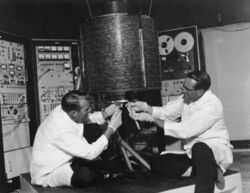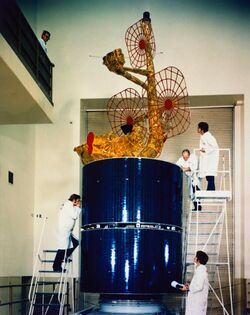Intelsat
Topic: Company
 From HandWiki - Reading time: 11 min
From HandWiki - Reading time: 11 min
 | |
 Tysons Tower, where Intelsat's satellite fleet is controlled from.[1] | |
| NYSE: I Russell 2000 Component | |
| Industry | Satellite communication |
| Founded | (August 20, 1964) |
| Headquarters | Tysons Corner, Virginia , U.S. |
Key people | David McGlade (Executive Chairman) Stephen Spengler (CEO since April 1, 2015)[2] |
| Revenue | |
Number of employees | +1110 (2011) |
| Website | www |
Intelsat Corporation—formerly INTEL-SAT, INTELSAT, Intelsat—is a communications satellite services provider. Originally formed as International Telecommunications Satellite Organization (ITSO, or INTELSAT), it was—from (August 20, 1964), to 2001—an intergovernmental consortium owning and managing a constellation of communications satellites providing international broadcast services.
(As of March 2011), Intelsat operates a fleet of 52 communications satellites, which is one of the world's largest fleet of commercial satellites.[3] They claim to serve around 1,500 customers and employ a staff of approximately 1,100 people.[4]
History
John F. Kennedy instigated the creation of INTELSAT with his speech to the United Nations on the 25th of September 1961.[5] Less than a year later, John F. Kennedy signed the Communications Satellite Act of 1962. INTELSAT was originally formed as International Telecommunications Satellite Organization (ITSO) and operated from 1964 to 2001 as an intergovernmental consortium owning and managing a constellation of communications satellites providing international broadcast services. In 2001, the international satellite market was fully commercialized, and the US predominant role in INTELSAT was fully privatized after 2001 as Intelsat was formed up as a private Luxembourg corporation.
International Governmental Organization: 1964–2001
The International Governmental Organization (IGO) began on (August 20, 1964), with 7 participating countries.[6] The 1964 agreement was an interim arrangement on a path to a more permanent agreement. The permanent international organization was established in 1973, following inter-nation negotiations from 1969 to 1971. The most difficult issue to "resolve concerned the shift from management of the system by a national entity to management by the international organization itself."[7]:46
On 6 April 1965, INTELSAT's first satellite, the Intelsat I (nicknamed Early Bird), was placed in geostationary orbit above the Atlantic Ocean by a Delta D rocket.
In 1973, the name was changed and there were 81 signatories.[8] INTELSAT was "governed initially by two international agreements: The Agreement setting forth the basic provisions and principles and structure of the organization, signed by the governments through their foreign ministries, and an Operating Agreement setting forth more detailed financial and technical provisions and signed by the governments or their designated telecommunications entities."—in most cases the latter are the ministries of communications of the party countries, but in the case of the United States, was the Communications Satellite Corporation (COMSAT),[9] a private corporation established by federal legislation to represent the US in international governance for the global communication satellite system.[7]:47 INTELSAT at that time directly owned and managed a global communications satellite system, and structurally consisted of three parts:[7]
- the Assembly of Parties—meeting every two years and concerned with aspects "primarily of interest to the Parties as sovereign States."[7]:48—with each country having one vote.
- the Meeting of Signatories—meeting annually and composed of all the signatories to the Operating Agreement—primarily working on financial, technical and program matters, with each countries' signatory having one vote.
- a Board of Governors, meeting at least four times each year, making decisions on design, development, establishment, operation and maintenance of the in-space assets, appointed by signatories, but weighted to each signatories "investment share" in the space assets.
The 1973 Agreement called for a seven-year transition from national to international management, but continued until 1976 to carve out "technical and operational management of the system [to the US signatory] the Communications Satellite Corporation [which had also] served as the Manager of the global system under the interim arrangements in force from 1964 to 1973."[7]:49 Later phases of the transition resulted in full international governance by 1980. Financial contribution to the organization, it's so-called "investment share," was strictly proportional to each member's use of the system, determined annually; and this corresponded to the weighted vote each would have on the Board of Governors.[7]:50
As of 2018, Intelsat provides service to over 600 Earth stations in more than 149 countries, territories and dependencies. By 2001, INTELSAT had over 100 members.[10] It was also this year that INTELSAT privatized and changed its name to Intelsat.[clarification needed]
Since its inception, Intelsat has used several versions (blocks) of its dedicated Intelsat satellites. Intelsat completes each block of spacecraft independently, leading to a variety of contractors over the years. Intelsat's largest spacecraft supplier is Space Systems/Loral, having built 31 spacecraft (as of 2003), or nearly half of the fleet.
The network in its early years was not as robust as it is now. A failure of the Atlantic satellite in the spring of 1969 threatened to stop the Apollo 11 mission; a replacement satellite went into a bad orbit and could not be recovered in time; NASA had to resort to using undersea cable telephone circuits to bring Apollo's communications to NASA during the mission.[11] During the Apollo 11 moonwalk, the moon was over the Pacific Ocean, and so other antennas were used, as well as INTELSAT III, which was in geostationary orbit over the Pacific.[12]
Commercialisation
By the 1990s, building and launching satellites was no longer exclusively a government domain and as country-specific telecommunications systems were privatized, several private satellite operators arose to meet the growing demand. In the U.S., satellite operators such as PanAmSat, Orion Communications, Columbia Communications, Iridium, Globalstar, TRW and others formed under the umbrella of the Alliance for Competitive International Satellite Services (ACISS) to press for an end to the IGOs and the monopoly position of COMSAT the US signatory to Intelsat and Inmarsat. In March 2001, the US Congress passed the Open Market Reorganization for the Betterment of International Telecommunications (ORBIT) Act[13] to privatize COMSAT and reform the role of the international organizations. In April 1998, to address US government concerns about market power, Intelsat's senior management spun off five of its older satellites to a private Dutch entity, New Skies Satellites, which became a direct competitor to Intelsat. To avert the US government's interference with Intelsat, Intelsat's senior management unsuccessfully considered relocating the IGO to another country.[citation needed]
Privatisation
On 18 July 2001, Intelsat became a private company, 37 years after formation. Prior to Intelsat's privatization in 2001, ownership and investment in INTELSAT (measured in shares) was distributed among INTELSAT members according to their use of services. Investment shares determined each member's percentage of the total contribution needed to finance capital expenditures. The organization's primary source of revenue was satellite usage fees which, after deduction of operating costs, was redistributed to INTELSAT members in proportion to their shares as repayment of capital and compensation for use of capital. Satellite services were available to any organization (both INTELSAT members and non-members), and all users paid the same rates.[citation needed]
Today, the number of Intelsat satellites, as well as ocean-spanning fiber-optic lines, allows rapid rerouting of traffic when one satellite fails. Modern satellites are more robust, lasting longer with a much larger capacity.[citation needed]
Intelsat Americas-7 (known formerly as Telstar 7 and now known as Galaxy 27) experienced a several-day power failure on 29 November 2004.[14] The satellite returned to service with reduced capacity.[15]
Intelsat was sold for U.S. $3.1bn in January 2005 to four private equity firms: Madison Dearborn Partners, Apax Partners, Permira and Apollo Global Management. The company acquired PanAmSat on 3 July 2006, and is now the world's largest provider of fixed satellite services, operating a fleet of 52 satellites in prime orbital locations.
In June 2007 BC Partners announced they had acquired 76 percent of Intelsat for about 3.75 billion euros.[16]
BC Partners has since sold all their share and Intelsat is a stand-alone company.
Intelsat S.A. (Luxembourg)
In April 2013, the renamed Intelsat S.A. undertook an initial public offering on the New York Stock Exchange, raising a net US$550 million, of which $492 million was paid immediately to reduce outstanding company debts of US$15.9 billion. In May, the company announced it would be purchasing four new high-performance Boeing EpicNG 702 MP satellites.[17][18]
There were talks that Intelsat was to merge with Softbank-backed OneWeb.[19] However, on 1 June 2017 it was announced that the bondholders would not accept the offer and the merger would be terminated as of 2 June 2017.[20]
In 2015 Intelsat reincorporated in Delaware and became Intelsat Corporation.
Operations
Intelsat maintains[when?] its corporate headquarters in Luxembourg, with a majority of staff and satellite functions. Administrative headquarters is located at the Intelsat Corporation offices in Tysons Corner, Virginia.[21] A highly international business, Intelsat sources the majority of its revenue from non-U.S. located customers. Intelsat's biggest teleport is the Teleport Fuchsstadt in Germany.[22]
In-space refueling demonstration project
(As of March 2011), Intelsat has agreed to purchase one-half of the 2,000 kilograms (4,400 lb) propellant payload that an MDA Corporation spacecraft satellite-servicing demonstration project would take to geostationary orbit. Catching up in orbit with four or five Intelsat communication satellites, a fuel load of 200 kilograms (440 lb) of fuel delivered to each satellite would add somewhere between two and four years of additional service life.[23] A near-end-of-life Intelsat satellite will be moved to a graveyard orbit 200 to 300 kilometres (120–190 mi) above the geostationary belt where the refueling will be done, "without consequence" to the Intelsat business.[3]
(As of March 2010), the business model was still evolving. MDA "could ask customers to pay per kilogram of fuel successfully added to [each] satellite, with the per-kilogram price being a function of the additional revenue the operator can expect to generate from the spacecraft’s extended operational life."[24]
The plan is that the fuel-depot vehicle would maneuver to several satellites, dock at the target satellite's apogee-kick motor, remove a small part of the target spacecraft's thermal protection blanket, connect to a fuel-pressure line and deliver the propellant. "MDA officials estimate the docking maneuver would take the communications satellite out of service for about 20 minutes."[24]
Satellites
Renaming
On February 1, 2007, Intelsat changed the names of 16 of its satellites formerly known under the Intelsat Americas and PanAmSat brands to Galaxy and Intelsat, respectively.[25][26]
Satellite list
Launch vehicles
Over time, Intelsat has worked with most of the commercial launch services providers worldwide. Their satellites are often among the most massive of their generation, requiring the most powerful and reliable rockets on the market at a given time. In the 21st century, most Intelsat missions were conducted by Arianespace with the European Ariane 4 and Ariane 5 launchers, and by ILS with Proton-K and Proton-M rockets manufactured by Khrunichev in Russia. Intelsat also took advantage of the equatorial Sea Launch offering with Zenit-3SL rockets launched from the Ocean Odyssey floating platform, until they suspended operations in 2014. On May 30, 2012, Intelsat signed a contract with SpaceX for one of the first Falcon Heavy launch vehicles,[27] marking the return of Intelsat to American launchers after many flights on Atlas II in the 1990s and a single Atlas V launch in 2009.
See also
- COMSAT
- Eutelsat
- Inmarsat
- Intelsat 708
- Intelsat Americas
- Intersputnik
- SES S.A.
References
- ↑ "Intelsat moves into new Tysons office, part of a wave of tenants wooed by Silver Line". The Washington Post. https://www.washingtonpost.com/news/digger/wp/2014/07/27/intelsat-moves-into-new-tysons-office-part-of-a-wave-of-tenants-wooed-by-silver-line/.
- ↑ "Executive Team". http://www.intelsat.com/about-us/executive-team/.
- ↑ 3.0 3.1 de Selding, Peter B. (2011-03-18). "Intelsat Signs Up for MDA’s Satellite Refueling Service". Space News. Archived from the original on 2012-03-21. https://archive.today/20120321160118/http://www.sbv.spacenews.com/satellite_telecom/110318intelsat-signs-for-mdas-satellite-refueling-service.html. Retrieved 2011-03-20. "the operator of the world’s largest fleet of commercial satellites — Intelsat has 52 in orbit. ... For this first demonstration mission, ... one of our satellites that is at the end of its life and about to be decommissioned ... will be taken out of geostationary orbit without consequence to our business, with the refueling done 200 to 300 kilometers above the geostationary belt."
- ↑ "Intelsat Company Facts". http://www.intelsat.com/about-us/company-facts/. Retrieved 2016-01-07.
- ↑ "JFK Address at U.N. General Assembly, 25 September 1961". John F. Kennedy Presidential Library and Museum. https://www.jfklibrary.org/learn/about-jfk/historic-speeches/address-to-the-united-nations-general-assembly.
- ↑ "United Nations Treaty, 20 August 1964.". United Nations. https://treaties.un.org/doc/Publication/UNTS/Volume%20514/volume-514-I-7441-English.pdf.
- ↑ 7.0 7.1 7.2 7.3 7.4 7.5 Leive, David M (1981). "Essential Features of INTEL SAT: Applications for the Future". Journal of Space Law 9 (45): 45–52. http://www.spacelaw.olemiss.edu/jsl/back-issues/jsl-9.html. Retrieved 5 September 2018.
- ↑ "United Nations Treaty, 20 August 1971.". United Nations. https://treaties.un.org/doc/Publication/UNTS/Volume%201220/volume-1220-I-19677-English.pdf.
- ↑ Menter, Martin (1981). "Commercial Participation in Space Activities". Journal of Space Law 9 (45): 53–68. http://www.spacelaw.olemiss.edu/jsl/back-issues/jsl-9.html. Retrieved 5 September 2018.
- ↑ Sommariva, Andrea (2018-02-28). The Political Economy of the Space Age: How Science and Technology Shape the Evolution of Human Society. Vernon Press. p. 29. ISBN 978-1-62273-264-7. https://books.google.com/books?id=ObiEDwAAQBAJ&pg=PA29.
- ↑ Donald E. Kimberlin (June 1, 1994). "Camelot on the Moon". http://www.oldradio.com/archives/warstories/dk.htm. Retrieved September 22, 2006.
- ↑ "On Eagle's Wings: The Parkes Observatory's Support of the Apollo 11 Mission" (PDF). Astronomical Society of Australia. July 1, 2001. http://www.parkes.atnf.csiro.au/apollo11/pasa/on_eagles_wings.pdf. Retrieved September 22, 2006.
- ↑ ORBIT Act
- ↑ "Wikinerds.org posting concerning IA-7 outage". http://portal.wikinerds.org/node/152.
- ↑ Gunter's Space Page – information on Galaxy 27[yes|permanent dead link|dead link}}]
- ↑ "BC Partners Wins Control Of Satellite Group Intelsat". SpaceDaily. 20 June 2007. http://www.spacemart.com/reports/BC_Partners_Wins_Control_Of_Satellite_Group_Intelsat_999.html.
- ↑ "Intelsat IPO Misses Target on Launch". Wall Street Journal. 18 April 2013. https://blogs.wsj.com/moneybeat/2013/04/18/intelsat-ipo-misses-target-on-launch/.
- ↑ Veronica Magan. "Intelsat Signs New Major Boeing Deal, Releases First Quarter Results". Via Satellite. http://www.satellitetoday.com/st/feature/Intelsat-Signs-New-Major-Boeing-Deal-Releases-First-Quarter-Results_41163.html.
- ↑ "Merger of OneWeb and Intelsat". https://www.reuters.com/article/us-oneweb-intelsat-m-a-idUSKBN1671CW.
- ↑ "SoftBank's Satellite Merger Disintegrates as Debt Deal Rejected". https://www.bloomberg.com/news/articles/2017-06-01/intelsat-bondholders-said-to-reject-proposed-merger-with-oneweb.
- ↑ Macerich's Tysons Tower Signs Intelsat as Anchor Office Tenant
- ↑ "Intelsat Teleports" (in en-US). http://www.intelsat.com/global-network/intelsatone/teleports/.
- ↑ de Selding, Peter B. (2011-03-14). "Intelsat Signs Up for Satellite Refueling Service". Space News. http://www.spacenews.com/satellite_telecom/intelsat-signs-for-satellite-refueling-service.html. Retrieved 2011-03-15. "if the MDA spacecraft performs as planned, Intelsat will be paying a total of some $200 million to MDA. This assumes that four or five satellites are given around 200 kilograms each of fuel. ... The maiden flight of the vehicle would be on an International Launch Services Proton rocket, industry officials said. One official said the MDA spacecraft, including its 2,000 kilograms of refueling propellant, is likely to weigh around 6,000 kilograms at launch."
- ↑ 24.0 24.1 Selding, Peter B. (2010-03-03). "MDA Designing In-orbit Servicing Spacecraft". Space News. http://spacenews.com/satellite_telecom/100303-mda-planning-inorbit-servicing-demo.html. Retrieved 2011-03-14. "the refueling vehicle would dock at the target satellite’s apogee-kick motor, peel off a section of the craft’s thermal protection blanket, connect to a fuel-pressure line and deliver the propellant. MDA officials estimate the docking maneuver would take the communications satellite out of service for about 20 minutes. ... The servicing robot would have an in-orbit life of about five years, and would carry enough fuel to perform 10 or 11 satellite-refueling or orbital-cleanup missions."
- ↑ ipsadmin. "Intelsat Infrastructure". Leading Provider of Satellite Services Worldwide – Intelsat S.A.. http://www.intelsat.com/network/satellite/new-names.asp.
- ↑ ipsadmin. "Intelsat Infrastructure". Leading Provider of Satellite Services Worldwide – Intelsat S.A.. http://www.intelsat.com/network/satellite/conversion-table.asp.
- ↑ Jeffrey Hill. "SpaceX Signs Falcon Heavy Launch Deal with Intelsat". Via Satellite. http://www.satellitetoday.com/st/headlines/38899.html,.
External links
| Wikimedia Commons has media related to Intelsat. |
- Intelsat, Ltd.
- Market Developments in the Global Satellite Services Industry and the Implementation of the ORBIT Act GAO-05-550T April 14, 2005
Data
[ ⚑ ] 38°56′30″N 77°03′49″W / 38.94167°N 77.06361°W
 KSF
KSF


